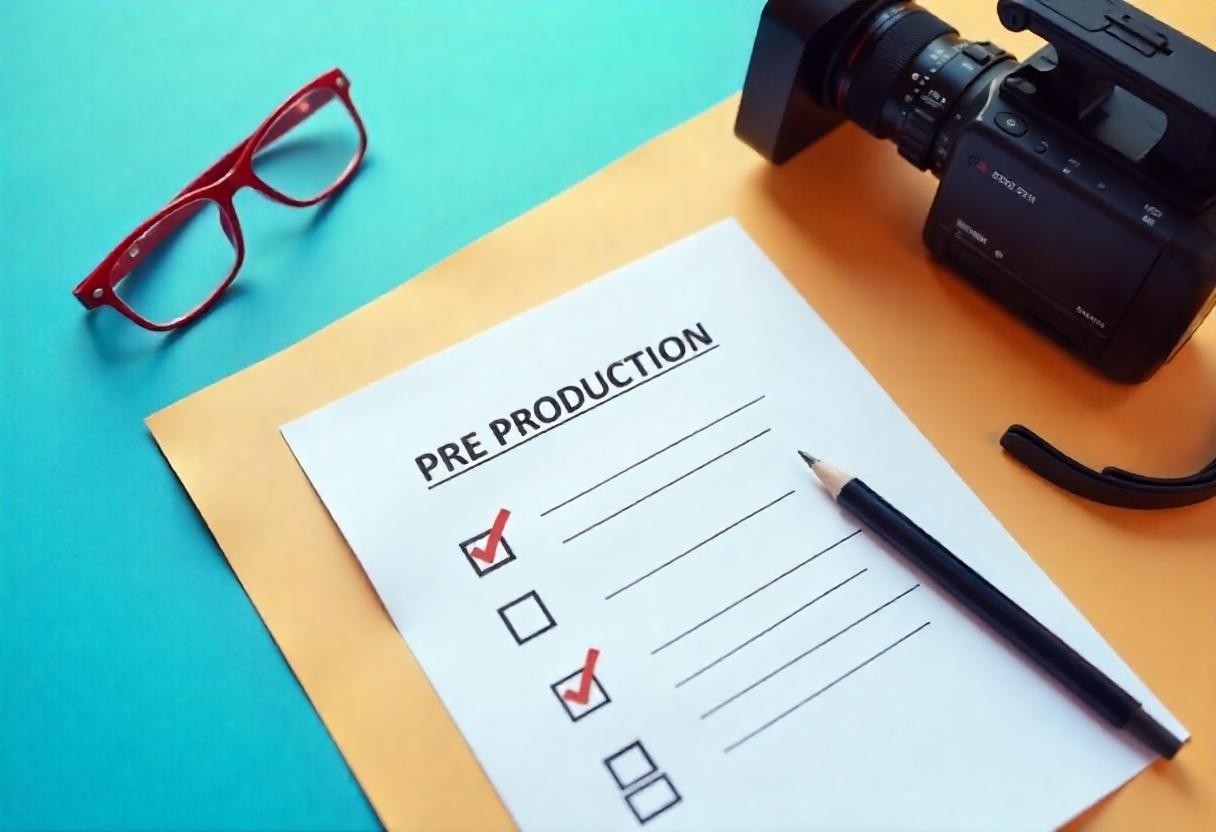Author Napoleon Hill once said,
“Plan your work and work your plan.”
These words highlight how important it is to create and execute a plan.
Before producing a video or film, there’s an important step that can make or break the project. It’s pre-production. Here, you do all the planning, outlining the tasks, and preparing resources/tools. This ensures everything (not just the camera) rolls smoothly.
The pre-production phase has distinct significance. It–
- Saves time and money
- Clarifies vision
- Prevents mishaps
- Improves team coordination
- Reduces onset stress
- Leads to quality output
To enjoy these perks, you need good planning, i.e. a thorough checklist.
Let’s walk you through that!
Key Takeaways: Pre-Production Checklist for Film & Video
- Understanding the Pre-Production Phase
- Initial Planning and Research
- Team Assembly
- Visual and Creative Planning
- Scheduling and Production Timeline
- Equipment Planning and Rentals
- Permissions, Permits, and Insurance
- Preparing for the Shoot
Understanding the Pre-Production Phase
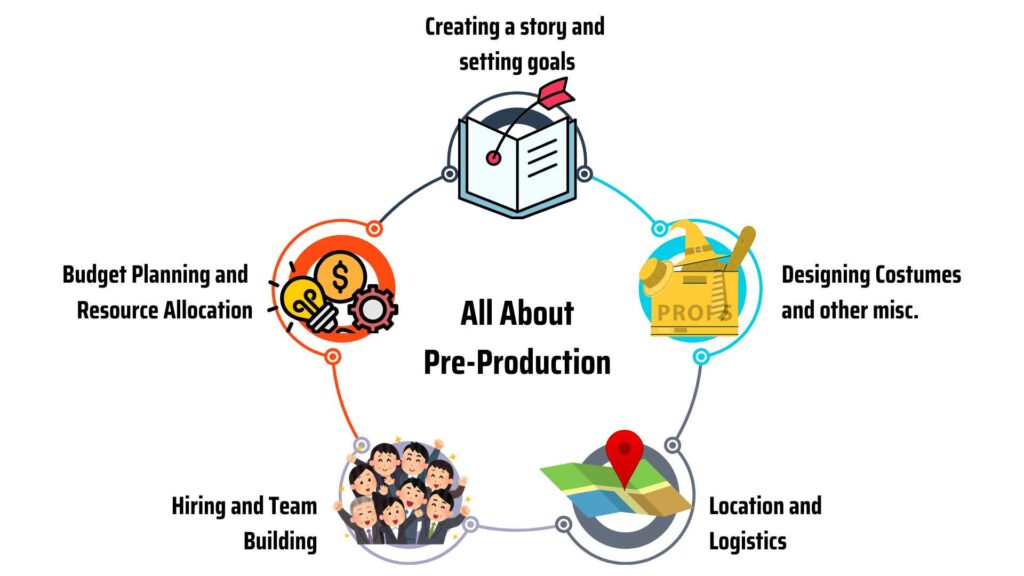
What Is Pre-Production Phase?
A phase of planning and organizing. That’s what it is.
A pre-production phase means you plan and prepare everything before actual filming starts.
Here you organize all the necessary tasks and checklists like:
- Creating a story
- Setting goals and scopes
- Budget panning
- Hiring a team
- Location scouting
- Logistic factors
- Designing costumes and sets
- Preparing resources
It’s all about ensuring you’re fully prepared before the cameras roll.
Why Is Pre-Production Important?
Saves Time and Money
Without a proper plan, it can result in two troubles:
- Overspending
- Overrun
Planning mainly ensures that you design each step carefully in advance. That way, everyone knows what to do and when to do it.
So, there will be less confusion and minimal chances of delays.
The pre-production phase also involves research and lets you set a clear budget accordingly. This helps reduce pricy last-minute changes and ensures everything runs smoothly.
Plus, you can spot early challenges and adjust without affecting time and budget.
Ensures Creative Clarity
During the pre-production phase, you define the vision and project style.
The phase lets you:
- Develop storyboards
- Create shot lists
- Discuss the theme and elements of the film
Such steps help make everything sorted and clear. It reduces confusion and creative conflicts on sets.
Cuts Down On-Set Stress
A good pre-production process helps you avoid problems before they can pop up. As a result, it lowers stress during filing.
To avoid last-minute issues, you just need to:
- Plan rehearsals
- Test equipment
- Block scenes early
These steps help prepare everyone and eventually help reduce pressure.
Improves Team Coordination
You gather and organize your crew in pre-production.
This also includes:
- Assigning roles
- Building a schedule
Such coordination helps boost effective workflow as they know their responsibilities and timing.
Initial Planning and Research
Concept Development
The concept is the core idea of your film or video. It suggests what the content will be about.
For this, list out all the objectives. Then narrow it down to specific ones. Define your vision. Ask yourself the concept and why you’re producing the video.
Is it to:
- Raise brand awareness
- Promote a product
- Increase engagement
- Educate your audience
- Build trust and connection
- Boost sales and revenue
- Generate leads
Based on this, create a concept. Consider factors like:
- Theme
- Story
- Narration style
- Visuals
- Music
- Target audience
- Call to action
For the concept, you may also need to:
- Define your goals
- Identify audience
- Develop key messages
- Plan distribution channels
Knowing your concept can work to keep you focused and avoid obstacles.
Script Finalization
A script works like a guide. As screenwriter, Meg Swertlow says,
“A script is a typed-out blueprint.”

[Source: Meg Swertlow]
Such a document contains directives for the actors and instructions for filming. This includes—
- Graphics
- Sound effects
- Visual and audio information
You can pen the script yourself or hire a scriptwriter. Note that the latter may increase the cost.
Once you have a script, take time to review and refine it. You can talk to a script consultant about that.
They provide a fresh perspective and improvements needed in the– story, dialogue, and pacing.
A polished script ensures a big perk. It gives your team and actors a clear direction.
Budgeting and Funding
When budgeting, you understand how much stuff will cost. It helps you make proper decisions without sacrificing content quality.
For this, you must study the cost range of each aspect. The expenses may include—
- Hiring cast and crew
- Equipment
- Rentals
- Props
- Permits and logistics
If there’s a video production team, you should have a separate budget for that.
The cost can vary big time.
It can go from $1000 to 200,000 based on diverse factors.
- Learn more about video production costs from this blog.
Here’s a template you can use for budgeting. Cinematographer
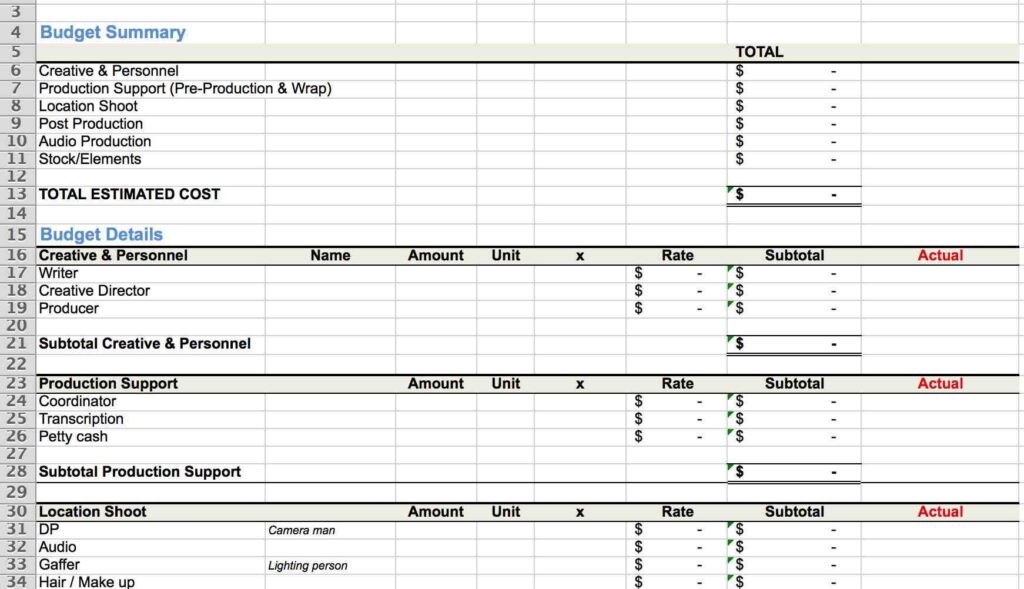
[Image Source: LinkedIn]
Once the budget is set, you identify how much funding you need for the film or video.
Following that, you can look into investors, crowdfunding, or sponsors for some funds.
A clear budget can stop you from overspending. With proper budget management, you can control your expenses.
Assembling The Team
Crew Roles and Responsibilities
Here’s a short breakdown of who does what during video and film production—
| Mains | Responsibilities |
| Director | Leads the creative vision, directs actors, and decides on shots. |
| Producer | Manages budget and logistics. |
| Cinematographer | Creates the film’s visual style through camera work and lighting. Handles background and landscape look. |
| Production Designer | Design the look of sets, props, and costumes to match your film style. |
| Editor | Assembles and edits footage |
Casting Tips
Having the right team helps shape the project’s style, quality, and direction. For this–
- Pick actors and crew who align well with the style and theme of your film or video.
- Hold multiple auditions and interviews for crews and actors. Look for versatility.
- Review previous projects to assess quality and reliability.
- Set clear expectations for roles and compensations to avoid misunderstandings.
Visual and Creative Planning
Storyboarding
A storyboard looks just like a comic strip of your film. It’s typically a graphic representation of how your content will unfold, shot by shot.
The tool lets you illustrate the moments of a story through a series of drawings or images.
It breaks down the action into individual panels just like this—
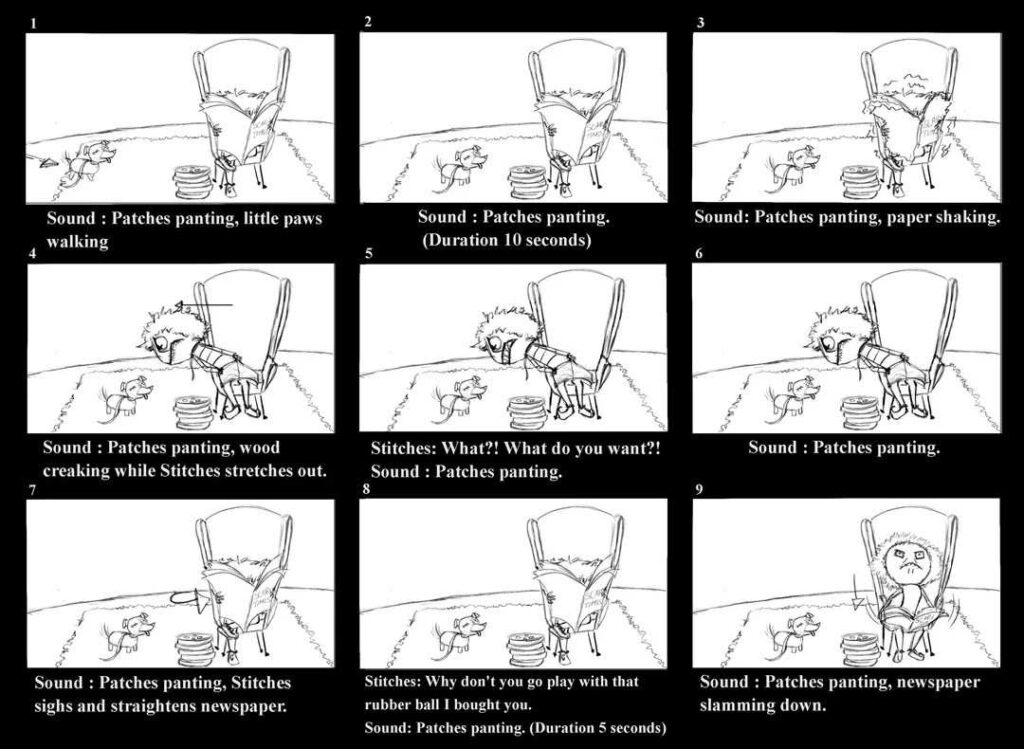
[Image Source: Reddit User]
This step helps visualize how scenes will look. It includes factors like-
- Camera angles like wide, medium, and close-up shots.
- Movements
- Dialogue
- Sound
When working on a storyboard during pre-production, make sure each panel portrays these factors.
Outline the purpose and key message. Align each scene with your brand goals.
Add props like graphics or settings that represent your brand identity.
Consider fades, cuts, or overlays.
Shot List Creation
A well-detailed list of every shot you want to capture. This includes—
- Shot type (close-up, wide, etc.)
- Location
- Scene
It helps keep the filming structured and prevents waste of time.
Location Scouting
Locations play a key role in making an impact. It creates the atmosphere of each scene.
So, make sure to scout well during the pre-production phase.
First, understand the theme of your video or film, then hunt for spots accordingly. Consider factors like–
| Factors | Reasons |
| Lighting | To get ideal visual quality |
| Space | Ease of movement and ensures crew can work smoothly |
| Background noise | The lower the noise, the better. It Prevents audio issues. |
A good spot can enhance the story of your content. So, scout locations and deal with permits as early as possible. This helps you avoid last-minute issues.
Art Direction
This step covers the look and feel of the set. This includes–
- Props
- Costumes
- Colors
- Textures
- Objects
Make sure each factor suits your film story.
A good art direction helps take your audience to the film world and make the content more immersive.
Scheduling and Production Timeline
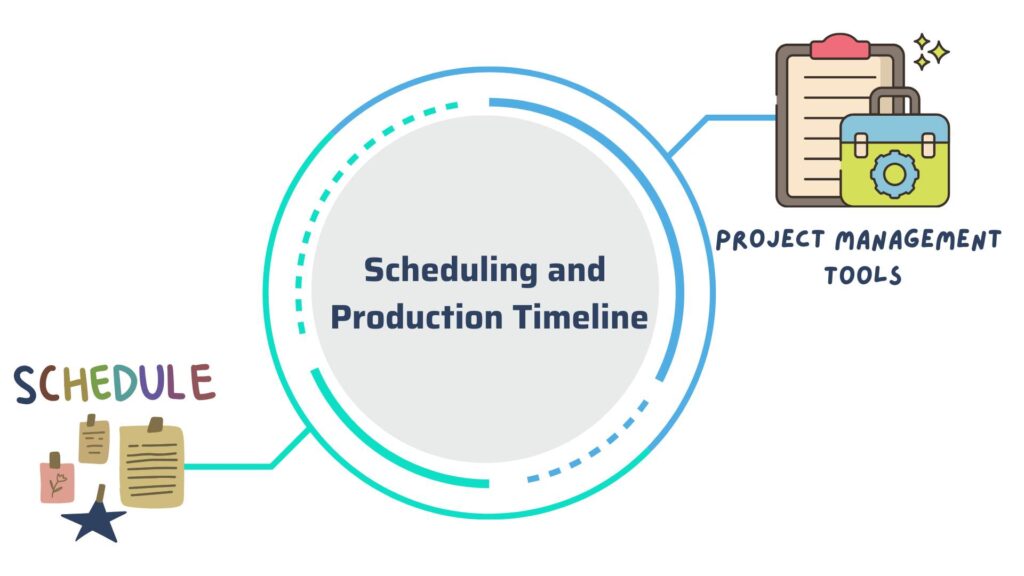
Project Management Software
The tools to keep you organized.
Such software helps with– planning, resource management, tracking of deadlines, execution, and delivery of a project. Plus, they also help communicate with your team.
It’s better to use a project management tool. You can either use a diary or software for this.
We suggest the latter since it’s more efficient and helps you stay productive properly.
Try out options like—
- Asana
- Monday
- Trello
- Studiobinder
Daily Shot List
You know it’s wiser if you break down each filming day by shots. For instance–
- Day 1
Shoot all cafe scenes close-ups and wide shots (Scenes 2,5, and 7) - Day 2
Film outdoor scenes in the park using drones (Scenes 3 and 8)
The list will help you know exactly what needs to be filmed each day. Result: You can manage timelines, maximize time, and avoid unwelcome delays.
Scheduling Actors and Crew
Make sure the actors and crew are available. This is extremely important.
Have an effective schedule. It helps avoid conflicts and keeps the project on track. To create one–
First, gather everyone’s availability in advance. Talk to your team, actors, and crew and settle on timing accordingly.
Depending on their availability, plan shooting days. But make sure the mains are free when needed.
Leave some flexibility in the schedule for surprises and changes. Prioritize important scenes first. This helps keep the work going smoothly and efficiently.
Equipment Planning and Rentals
Equipment List
List all the equipment you need to buy, borrow, or rent. Look for gears that fit your budget and visual styles.
Knowing what you need beforehand can also help prevent unnecessary rentals. Here’s a small equipment checklist–
| Equipment | Tools | Examples | Purpose |
| Camera | DSLRs | Canon Rebel EOS SL3 | Sharp, premium, and vivid footage. |
| Mirrorless options | Nikon Z 6III | ||
| Microphones | Shotgun mics 600 | Sennheiser MKH416 | Crisp, clear audio. |
| Lavalier mics | RØDE smartLav+ | ||
| Lighting Kits | Softbox lighting kits | NEEWER Softbox Lighting Kit | Eliminate harsh shadows. |
| Stands | Sturdy tripods and monopods | Manfrotto 504X 635 | Stable shots |
Rental Considerations
Best for those with a tight budget.
You actually don’t have to buy it all when you can rent. Because renting is more reasonable.
So, you can save money BIG TIME.
Before taking one, compare rental houses for the best prices. Check for package deals that cover multiple items.
Many service providers offer discounts, especially if you keep the rental equipment for a longer period.
Backup Equipment
Have spares and extra equipment. Shooting stuff can break or malfunction at times. It shouldn’t halt the production process.
For this, always keep extras. This can be—
- Batteries
- Cables
- Camera
Permissions, Permits, and Insurance
Permit Requirements
Some places might require you to ask for permission to shoot. This can be public places or private ones. Spots like–
- Streets
- Parks
- Government buildings
- Museum
- Historical places
- State Property
These fall under the jurisdiction of local authorities, so permits are essential.
You may also need a permit to film in some tourist or other places. It depends on the representatives and owners.
To secure that–
- Check with local authorities
- Understand the requirements and costs
- Provide details of your video to film shooting
- Submit required documents and fees
- Follow their guidelines
Having a permit can keep your project safe, that too legally. Plus, it prevents interruptions from authorities.
Insurance Coverage
Accidents during filming can happen. It’s not something unexpected.
In that case, insurance saves the day.
If mishaps pop up like someone getting hurt and equipment getting damaged, insurance covers the cost.
It protects everything involved–
- Cast
- Crew
- Equipment
Having insurance can also help you prevent costly lawsuits and replacement costs.
Risk Management
Make sure you have someone on set who oversees safety on set. If not, assign someone to do it.
They will–
- Check equipment
- Ensure clear walkways
- Communicate emergency protocols
Here Are Some Risk Management Strategy Tips—
- Hold a safety meeting before filming to explain safety procedures and possible risks.
- Ensure all things are in good condition and used properly.
- Use signs to warn of hazards like wet floors, heavy stuff, etc.
- Have a first aid kit on hand.
Preparing for the Shoot
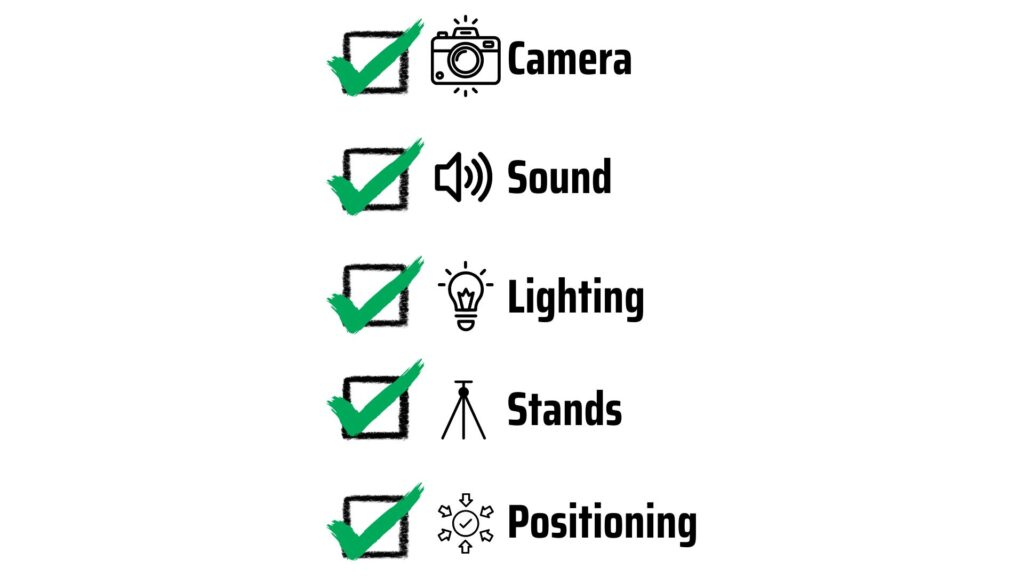
Rehearsals and Blocking
Practice always makes you perfect. So make people rehearse as much as you can.
Rehearsals are more of a “pre-production” thing than “production”.
It’s because the actors practice before the actual performance.
The dry run helps them refine their lines and movements. It also blocks and defines where they’ll stand or move within each scene.
Because they’ll be rehearsing before the shooting day, it’ll work to save time and performance quality too.
Tech Rehearsal
Pre-production also means tech rehearsals along with actor rehearsals. It refers to a full assessment of equipment and setup.
This includes checking–
- Camera
- Sound
- Lighting
- Stands
- Positioning
Doing this can help you identify issues with equipment or layout. Result:
You get time and scope to fix them before filming.
Finals Checks
Before the shoots, make sure—
- Everything is ready
- Everyone knows their schedule
- The equipment is working properly
- The crew has everything they need
Frequently Asked Questions
Developing a concept, outlining tasks, and assigning them. These are the most important pre-production steps. Some other ones are–
➜ Script finalization
➜ Budgeting
➜ Casting
➜ Location scouting
➜ Scheduling
Pre-production can last between 2 and 6 months. It depends on factors like–
➜ Complication of the topic
➜ Budget
➜ Location scouting
➜ Availability of crew, team, and actors
Try Monday.com. This is one of the best for organizing a film pre-production checklist.
You can also use–
➜ Asana
➜ Trello
Proper planning, project management tools, and clear schedules— can help keep the production process smooth and effective.
Double-Check All Essentials In Pre-Production
Pre-production is just like the base of a successful film or video project. It’s important to have a solid base otherwise the structure (the production) can collapse.
You don’t want that right.
To avoid that, have proper planning. This checklist covers around 95% of essential steps. Following it can help you work efficiently.
Let’s leave a 5% margin for some flexibility.

Founder at LocalEyes Video Production | Inc. 5000 CEO | Emmy Award Winning Producer

